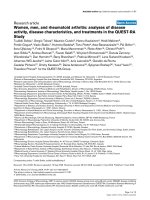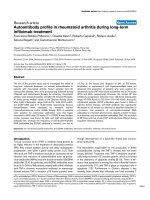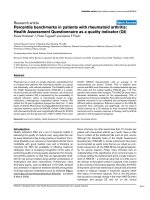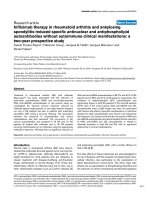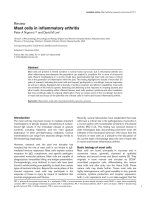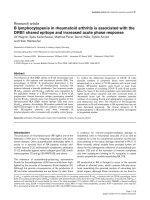Báo cáo y học: "Interleukin-7 deficiency in rheumatoid arthritis" ppsx
Bạn đang xem bản rút gọn của tài liệu. Xem và tải ngay bản đầy đủ của tài liệu tại đây (38.4 KB, 2 trang )
42
γ
c
= common cytokine receptor γ chain; IL = interleukin; IL-7Rα = IL-7 receptor α chain; RA = rheumatoid arthritis; SCID = severe combined
immunodeficiency; TNF-α = tumor necrosis factor-α; TRECs = T cell receptor excision circles.
Arthritis Research & Therapy Vol 7 No 1 Leonard
Rheumatoid arthritis (RA) is one of the most common
human autoimmune diseases, with a prevalence of about
1%. Because of this high prevalence as well as the
severely debilitating nature of the disease, considerable
efforts have been devoted to the treatment of RA. In the
current issue of this journal, Ponchel and colleagues [1]
investigate the basis for the prolonged lymphopenia of
CD4
+
T cells after lymphocyte-depleting therapy
specifically of patients with RA in comparison with other
disorders, and report that interleukin-7 (IL-7) is depleted.
The successful treatment of RA remains an area of
considerable challenge. Therapeutic approaches in the past
several decades have included corticosteroids, methotrexate,
sulfasalazine, cyclophosphamid, cyclosporine, leflunomide,
mycophenylate, and hydroxychloroquine; newer approaches
include immune-based targeting of tumor necrosis factor-α
(TNF-α) and interleukin-6 as well as the use of monoclonal
antibodies to induce T-cell depletion [2–4].
The major pathology of RA occurs in the synovium, and it
has been established that T cells and macrophages are
the major cell types in the pannus and that fibroblast-like
synoviocytes are also relevant in RA pathogenesis and
represented in synovium/pannus [5]. The accessibility of
synovial fluid has permitted the documentation of elevated
levels of cytokines, including pro-inflammatory cytokines
such as IL-1, TNF-α, and IL-6 and a large range of others
[5]. The evidence in support of an immune basis has led to
lympho-depleting therapies, including, for example, specific
monoclonal antibodies or high-dose cyclophosphamide
with autologous stem cell rescue. Whereas T-cell
depletion is potentially an effective approach, it is crucial
that the rescue can occur, and it is clear that this rescue
requires IL-7, which can act as both a growth factor and
survival factor and contributes to the expansion of both
naive and memory T cells [6–8]. Although a critical
‘cytokine network’ related to RA has been extensively
studied, IL-7 levels have previously been reported in major
reviews as unknown [3,5], and IL-7 deficiency has hitherto
not been associated with RA.
To investigate the basis for delayed repopulation, Ponchel
and colleagues studied patients with RA and discovered, as
reported in this issue, that circulating levels of IL-7 are
diminished in patients with RA [1]. Moreover, they found that
the number of cells containing T cell receptor excision circles
(TRECs), which represents a measure of T-cell receptor
gene rearrangement, was decreased. These findings were
evident across a range of patients with RA and were not
obviously affected by age or sex. The ability of bone marrow
stromal cells to produce IL-7 in long-term culture also was
diminished. Production of IL-7 was defective even when
clinical remission was induced by blockade of signaling by
Commentary
Interleukin-7 deficiency in rheumatoid arthritis
Warren J Leonard
Laboratory of Molecular Immunology, National Heart, Lung, and Blood Institute, National Institutes of Health, Bethesda, Maryland, USA
Corresponding author: Warren J Leonard,
Published: 20 December 2004
Arthritis Res Ther 2005, 7:42-43 (DOI 10.1186/ar1492)
© 2004 BioMed Central Ltd
See related research by Ponchel et al., page 47 [ />Abstract
Interleukin-7 (IL-7) is a stromal factor that is crucial for the development of T lymphocytes in humans
and mice, and also B lymphocytes in mice. IL-7 can act as a T cell growth factor as well as a critical
anti-apoptotic survival factor. The essential non-redundant role of this cytokine for T cell development
in vivo is indicated by the phenotype of murine knockout models as well as by humans with a
T
–
B
+
NK
+
form of severe combined immunodeficiency (SCID) resulting from mutations in IL-7
receptor α chain. IL-7 deficiency has now been found in patients with rheumatoid arthritis, a finding
that relates not only to the T-lymphocyte status in this disease but also to the ability of patients with
rheumatoid arthritis to recover from therapy-induced lymphopenia.
43
Available online />TNF-α. This defect was restricted to IL-7 rather than its
receptor (IL-7R) because the expression of the IL-7 receptor
α chain (IL-7Rα) was normal, and peripheral blood
mononuclear cells responded normally to exogenous IL-7.
Strikingly, when patients with RA were treated with
chemotherapeutic regiments, there was defective recovery
of both CD4 and CD8 T cell populations, including both
naive and memory cells. This was associated with
diminished TRECs. In contrast to patients with tumors,
who had a lymphopenia-associated increase in IL-7, no
such increase was found in the patients with RA.
IL-7 is a four-α-helical type I cytokine that binds to a
receptor comprising IL-7Rα and the common cytokine
receptor γ chain, γ
c
[9,10]. γ
c
is mutated in humans with X-
linked severe combined immunodeficiency (X-linked
SCID), in which T and NK cells are absent and B cells are
present but non-functional. γ
c
is also a component of the
receptors for IL-2, IL-4, IL-9, IL-15, and IL-21, as well as
IL-7, explaining the profound defects in X-linked SCID
[9,11]. IL-7Rα is also a component of the receptor for
thymic stromal lymphopoietin [12,13], a factor that
preferentially affects the expansion of CD4 cells, whereas
IL-7 affects both CD4 and CD8 cells [14,15]. Interest-
ingly, mutations in IL-7Rα cause a form of SCID in which T
cells are absent but the development of B and NK cells is
normal [16]. It has been speculated that IL-7 deficiency
would also result in SCID with a similar phenotype, but
such patients have not yet been identified [6,9].
Whereas IL-7Rα-deficient SCID patients readily engraft
bone marrow from haploidentical donors, the expectation
is that this would not occur in IL-7 deficiency because the
grafts would not be supported by the host stroma [6]. The
study by Ponchel and colleagues [1] is important in
supporting this speculation, but more importantly it
identifies a clinical syndrome in which IL-7 deficiency
affects T cell development in vivo. It is noteworthy that the
defect in IL-7 production is partial, so one can only
speculate about the nature of the defect that might evolve
in a setting of complete IL-7 deficiency in humans.
Several important issues are raised by this study. First,
given the difficulty in reconstituting T cells in patients with
RA, therapeutic approaches that minimize the elimination of
T cells are likely to be more desirable. Second, the basis
for the defective IL-7 production in RA is unclear and is an
interesting area for future investigation. In fact, very little is
known about the regulation of the IL7 gene, whereas
recently information on both positive [17] and negative
[18,19] regulation of IL7R gene expression in T cells has
become available. Third, it will be crucial to determine
whether the defect in IL-7 production in RA represents a
global stromal cell defect or whether it is a relatively
selective defect. In this regard, it will also be interesting to
determine the levels of thymic stromal lymphopoietin in
patients with RA. Thus, the study by Ponchel and
colleagues [1] not only provides interesting information
about IL-7 deficiency in patients with RA but also clearly
indicates several areas in need of further investigation.
Competing interests
The author(s) declare that they have no competing interests.
Acknowledgements
I thank Drs Paul Plotz and Crystal Mackall for critical
comments.
References
1. Ponchel F, Verburg RJ, Bingham SJ, Brown AK, Moore J, Protheroe
A, Short K, Lawson CA, Morgan AW, Quinn M, et al.: Interleukin-
7 deficiency in rheumatoid arthritis: consequences for therapy-
induced lymphopenia. Arthritis Res Ther 2005, 7:R80-R92.
2. Cronstein BN: Therapeutic cocktails for rheumatoid arthritis:
the mixmaster’s guide. Arthritis Rheum 2004, 50:2041-2043.
3. Feldmann M, Maini RN: Anti-TNF
αα
therapy of rheumatoid arthri-
tis: what have we learned. Annu Rev Immunol 2001, 19:163-196.
4. Nishimoto N, Yoshizaki K, Miyasaka N, Yamamoto K, Kawai S,
Takeuchi T, Hashimoto J, Azuma J, Kishimoto T: Treatment of
rheumatoid arthritis with humanized anti-interleukin-6 recep-
tor antibody. Arthritis Rheum 2004, 50:1761-1769.
5. Feldmann M, Brennan FM, Maini RN: Role of cytokines in
rheumatoid arthritis. Annu Rev Immunol 1996, 14:397-440.
6. Puel A, Leonard WJ: IL-7R
αα
-dependent signaling is required
for T-cell development; basis for T
–
B
+
NK
+
SCID in humans.
Immunol Allergy Clin 2000, 20:51-63.
7. Fry TJ, Mackall CL: Interleukin-7: from bench to clinic. Blood
2002, 99:3892-3904.
8. Schluns KS, Lefrancois L: Cytokine control of memory T-cell
development and survival. Nat Rev Immunol 2003, 3:269-279.
9. Leonard WJ: Cytokines and immunodeficiency diseases. Nat
Rev Immunol 2001, 1:200-208.
10. Leonard WJ. Type I cytokines and interferons and their recep-
tors. In Fundamental Immunology. 5th edition. Edited by Paul
WE. Philadelphia: Lippincott Williams & Wilkins; 2003:701-747.
11. Ozaki K, Spolski R, Feng CG, Cheng J, Sher A, Liu C,
Schwarzberg PL, Leonard WJ: A critical role for IL-21 in regulat-
ing immunoglobulin production. Science 2002, 298:1630-1634.
12. Pandey A, Ozaki K, Baumann H, Levin SD, Puel A, Farr AG,
Ziegler SF, Leonard WJ, Lodish HF: Cloning of a receptor
subunit required for signaling by thymic stromal lymphopoi-
etin. Nat Immunol 2000, 1:59-64.
13. Park LS, Martin U, Garka K, Gliniak B, Di Santo JP, Muller W,
Largaespada DA, Copeland NG, Jenkins NA, Farr AG, et al.:
Cloning of the murine thymic stromal lymphopoietin (TSLP)
receptor: formation of a functional heteromeric complex
requires interleukin 7 receptor. J Exp Med 2000, 192:659-70.
14. Watanabe N, Hanabuchi S, Soumelis V, Yuan W, Ho S, de Waal
Malefyt R, Liu YJ: Human thymic stromal lymphopoietin pro-
motes dendritic cell-mediated CD4+ T cell homeostatic
expansion. Nat Immunol 2004, 5:426-434.
15. Al-Shami A, Spolski R, Kelly J, Schwartzberg PL, Pandey A,
Leonard WJ: A role for thymic stromal lymphopoietin (TSLP) in
CD4
+
T cell development. J Exp Med 2004, 200:159-168.
16. Puel A, Ziegler SF, Buckley RH, Leonard WJ: Defective IL7R
gene expression in T
-
B
+
NK
+
severe combined immunodefi-
ciency. Nat Genet 1998, 20:394-397.
17. Xue H-H, Bollenbacher J, Rovella V, Tripuraneni R, Du Y-B, Liu C-
Y, Williams A, McCoy JP, Leonard WJ: GA binding protein regu-
lates interleukin-7 receptor
αα
chain gene expression in T
cells. Nat Immunol 2004, 5:1036-1044.
18. Xue HH, Kovanen PE, Pise-Masison CA, Berg M, Radovich MF,
Brady JN, Leonard WJ: IL-2 negatively regulates IL-7 receptor
αα
chain expression in activated T lymphocytes. Proc Natl Acad
Sci USA 2002, 99:13759-13764.
19. Park JH, Yu Q, Erman B, Appelbaum JS, Montoya-Durango D, Grimes
HL, Singer A: Suppression of IL7R
αα
transcription by IL-7 and
other prosurvival cytokines: a novel mechanism for maximizing
IL-7-dependent T cell survival. Immunity 2004, 21:289-302.
